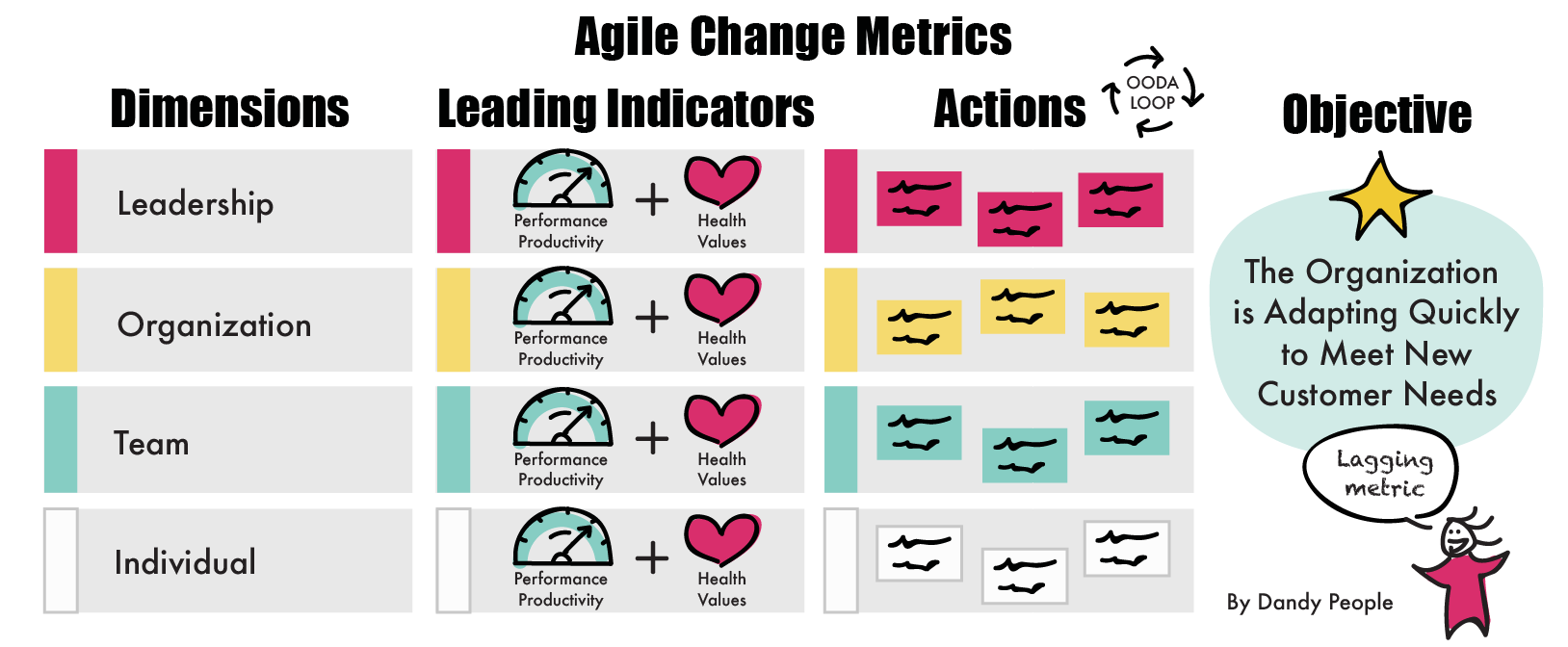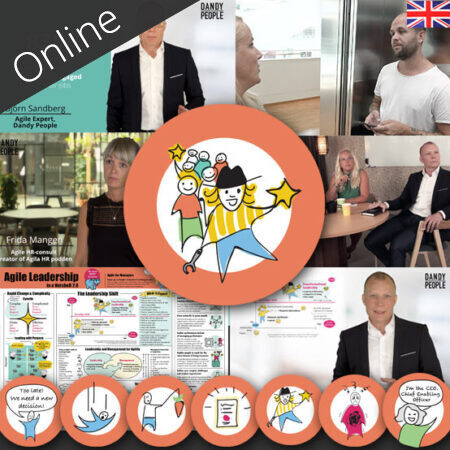We believe in visual models that support common views, transparency and collaboration, that helps us as individuals and teams shift towards a growth mindset.
The system shift poster was initially created due to our need within Dandy People to find common ways to think about and work with Agile transformations without getting fixed to specific frameworks – and also in an efficient way communicate how we work towards our customers.
The poster is our combined experience within the team at Dandy People, condensed into one page of goodies.
Questions we wanted to answer in this poster
- What are the different choices we have on where to start?
- What structured ways of moving towards Agility do we see?
- What type of leadership is needed to enable an Agile organization?
- Why do we start with structures and not just training?
- How do we enable sustainability in change that never ends?
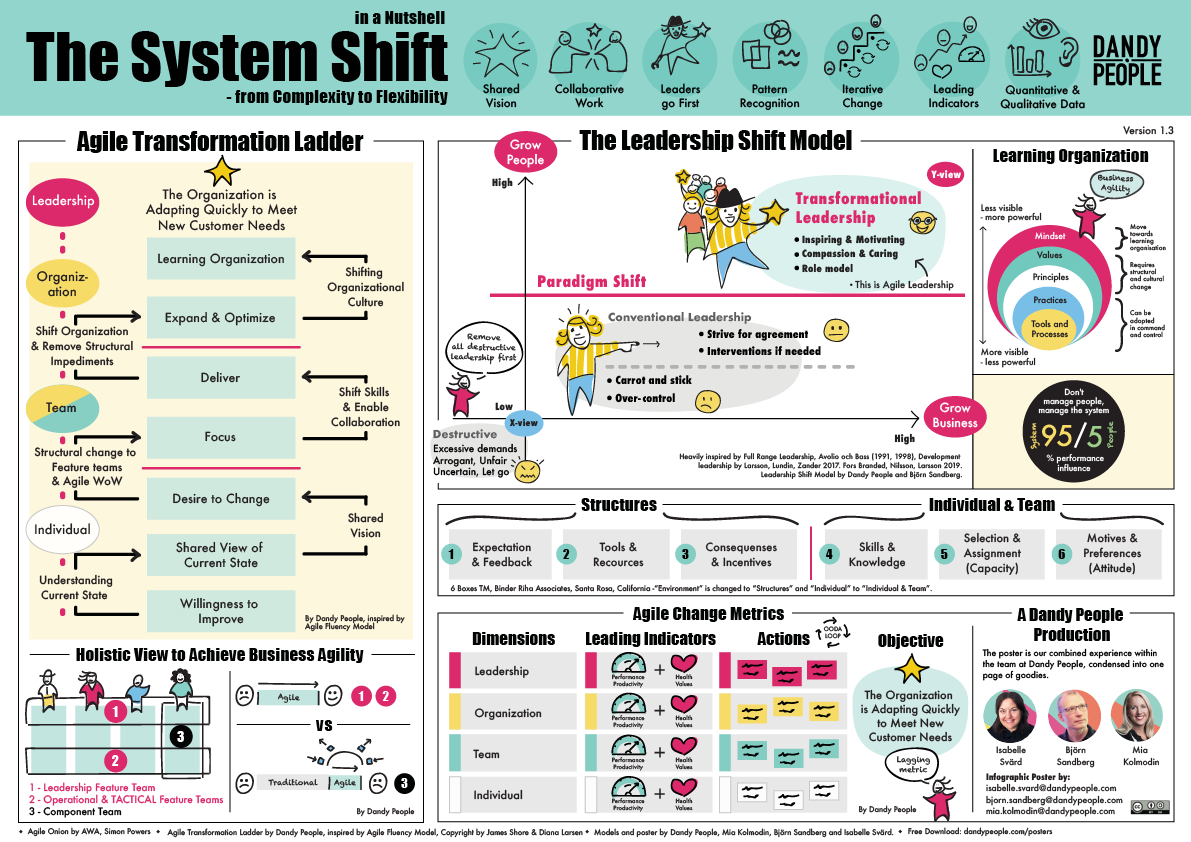
Download the System shift in a Nutshell poster for free here (PDF) >
What are the different choices we have on where to start? – Holistic view to achieve Business Agility
We have seen many organizations start their agile journey within one part of the existing organization, mostly within IT (component teams). For traditional organizations to become more innovative, have shorter time to market and stay relevant as employees and for their customers, that is no longer enough. We suggest that you work “bottom up” – and “top down”, and that you create cross functional feature teams on both operational level AND on leadership level, as far up in the hierarchy as possible. A cross functional leadership team is needed to give focus to the organization and to remove impediments from the operational teams as quickly as possible. Traditional structures are too slow and will not suffice.
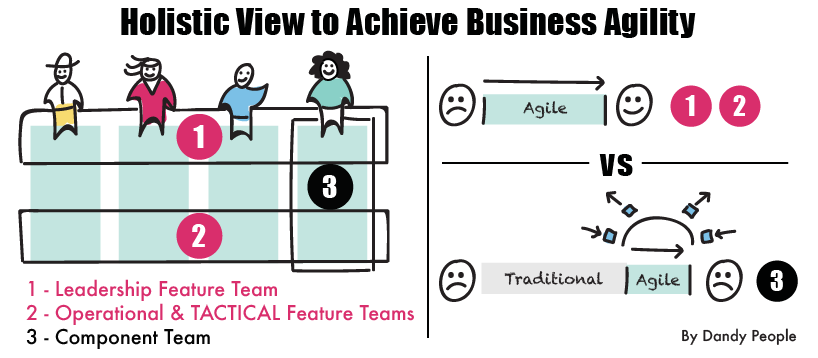
What structured ways of moving towards Agility do we see? – The Agile Transformation Ladder
The ladder is helping us see the necessary steps that traditional organization need to move through to become flexible and highly efficient.
The change process happens in 4 dimensions:
-
- Individual
- Team
- Organization
- Leadership
Visualized in the ladder you can see that leadership runs like a red thread from the bottom to the top. Leaders need to go first to act as a role model and enable improvements of the system. You will be able to read more about the ladder in an upcoming post.
Agile Transformation Ladder by Dandy People, inspired by Agile Fluency Model, Copyright by James Shore & Diana Larsen.
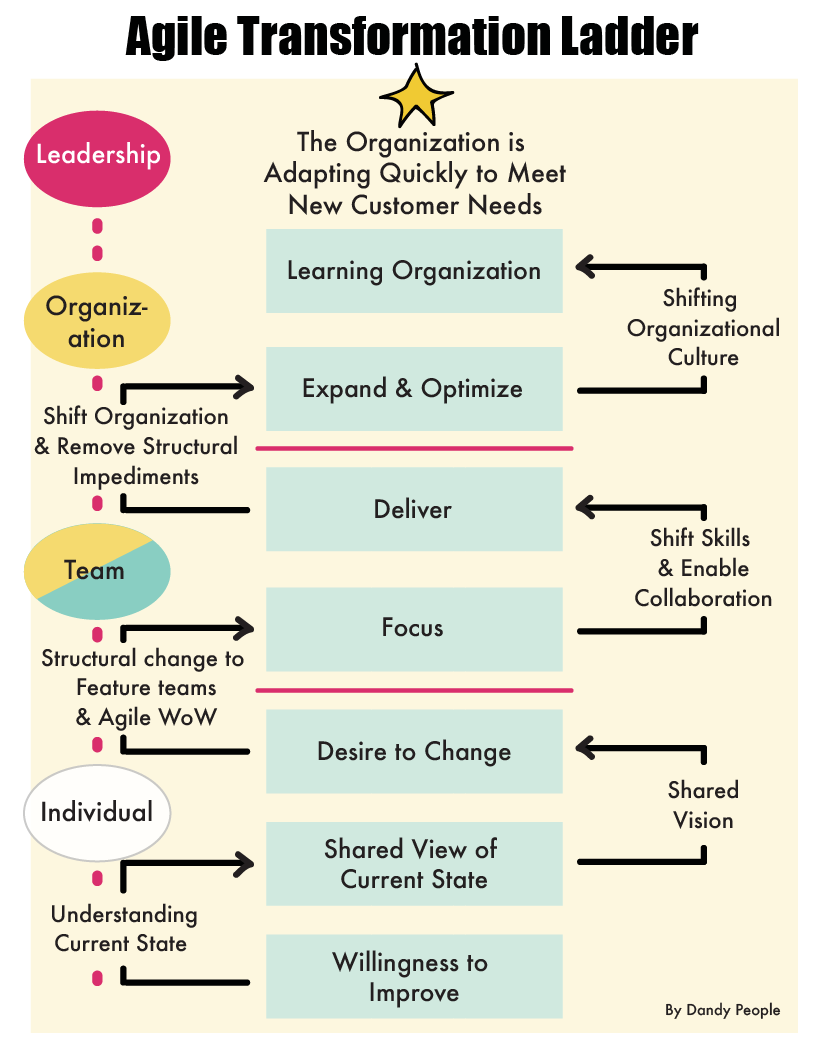
What type of leadership is needed to enable an Agile organization? – the Leadership Shift Model
The Leadership Shift Model shows the paradigm shift in leadership today where new leadership behaviours are needed in a VUCA-world to be able to improve business. Instead of traditional ways that focus on managing people we need to shift towards growing people to enable business growth. Traditional conventional leadership focuses on striving for agreements and to make interventions if needed, and if even further down the use of “carrot and stick”, reward and punishment and being over controlling is common. These conventional leadership styles (and systems) are holding people back as well as holding their ability to innovate and solve real customer problems. In the short term it might look as your organization is delivering, but long term your business will suffer.
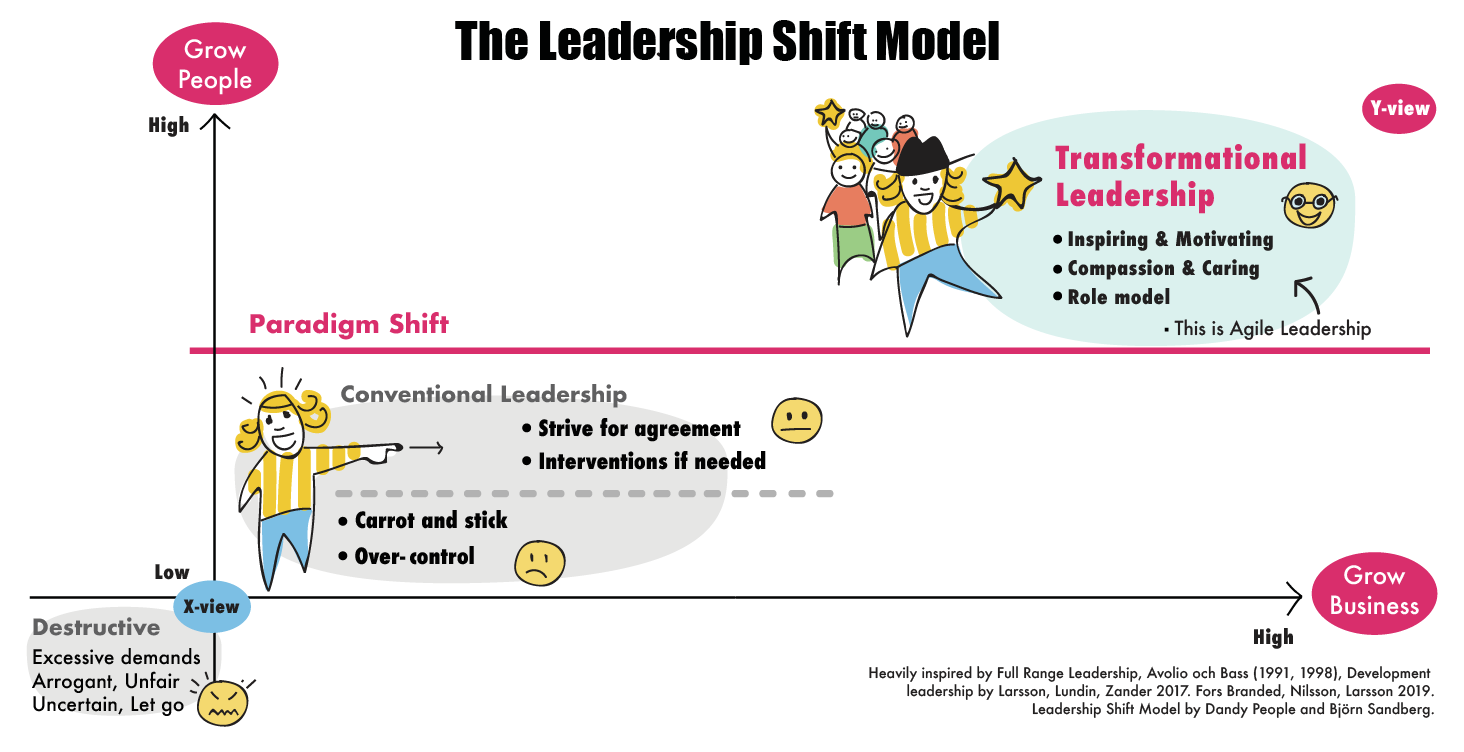
Even further down in the model below the lower line we have the destructive leadership. Resent research shows that removing these behaviors completely is what will give the most impact in most organization, when those are gone, the rest of the leaders can more easily start to practice more positive leadership behaviors.
Above paradigm shift-line we have the Transformative leadership style which focuses on behaviors such as inspiring and motivating, showing compassion and caring for others as well as walking the talk and being a role model. It is in this leadership style modern leadership types lies, such as Servant Leadership, Coaching Leadership, Management 3.0, Catalyst Leadership – and others. This is the type of leadership that is needed to become Agile.
The view on humans
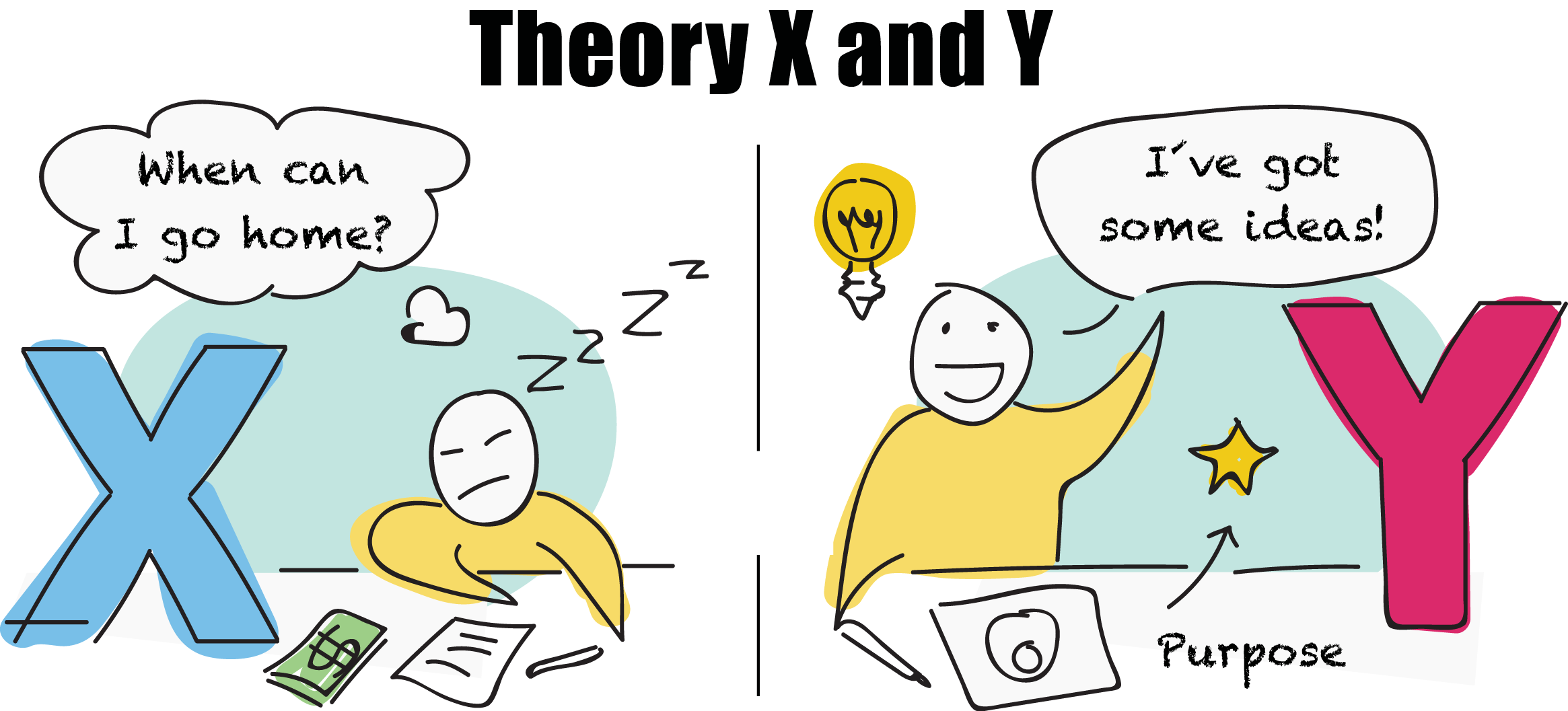
If we have an X view on people we believe they are lazy and don’t want to do a good job. They need to be managed and controlled to do their work and have very little creativity. This is reflecting how traditional management processes are set up.
If we have an Y view on people we believe that under the right conditions people like to work and that they are creative. People are motivated when they take ownership and set their own goals. This is a modern management view for the knowledge era of today.
Traditional leadership styles support the X-view, and so do also the structures we use in our traditional organizations. The connection between the Theory X and Y and different leadership styles is shown in the diagram.
The leadership shift model is heavily inspired by Full Range Leadership, Avolio och Bass (1991, 1998), Development leadership by Larsson, Lundin, Zander 2017. Fors Branded, Nilsson, Larsson 2019 and created by Björn Sandberg at Dandy People.
Why do we start with structures and not just training? – Six Boxes
The Six Boxes model got some space in the poster because it’s showing why we can’t change and become Agile just by training people and giving them new capabilities. If we do so the teams might not become well functioning and high performing, and we will not get the business outcome we are looking for. Instead once we have a shared incentive and vision we need to start with structural changes to enable some teams to start working Agile in Feature Teams. Once that is done, we can start working with skills and knowledge.
6 Boxes TM, Binder Riha Associates, Santa Rosa, California -“Environment” is changed to “Structures” and “Individual” to “Individual & Team”.

How do we measure success of Agile transformations, even cultural change? – Agile Metrics
To work in a structured way step by step, visualizing and collaborating is crucial in change. In an Agile organization this is continuous work, and with a traditional organizaton going Agile this has to be part of the daily work too. Good metrics are metrics that change quickly and that we can access in a not too cumbersome way, and they should mean something for the people in the organization. What happens if we see no progress, or if we get better?
We have divided the metrics in two parts, health metrics and performance metrics. Health metrics are how happy our customers and stakeholders are with our work and how engaged and happy our employees are, this could include sick leave and turnaround if those are numbers helping us see if the actions we take lead to improvements of current state. Performance are often speed of delivery end to end and the quality of our deliveries, which can include different aspects of quality, security, technical – and usability quality. We can also measure our level of change within the different dimentions, leadership, organization, team and individual to see our capability to improve.
How do we enable sustainability in change that never ends? – Learning Organization
We need to work with not only processes and tools or even practices to succeed, starting with connecting the change to our shared values and create an understanding of the principles that will enable the change we need. Doing so we will enable a change in mindset and eventually in the culture and building a learning organization that can be flexible and transform continuously based on our context and strategic needs.
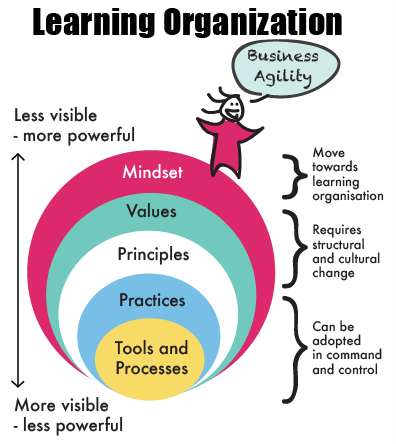
Thank you all Dandys for joining in and collaboratively creating this. Specifically thanks to Isabelle Svärd and Björn Sandberg who was taking the time to teaming up to build, test and tweak it with me. It makes me so proud to be part of this amazing team!
Free to download, use and share
The posters is published under Creative Commons License, so please use it and share it as you like. If you are interested in doing a translation to any other languages please let me know and I will help you with the file and publish it here in the blog as well.
You are free to:
Share — copy and redistribute the material in any medium or format
Adapt — remix, transform, and build upon the material for any purpose, even commercially.
This license is acceptable for Free Cultural Works.
The licensor cannot revoke these freedoms as long as you follow the license terms.
Under the following terms:
Attribution — You must give appropriate credit, provide a link to the license, and indicate if changes were made. You may do so in any reasonable manner, but not in any way that suggests the licensor endorses you or your use.
ShareAlike — If you remix, transform, or build upon the material, you must distribute your contributions under the same license as the original.
No additional restrictions — You may not apply legal terms or technological measures that legally restrict others from doing anything the license permits.
Here you find all the other Free Agile in a Nutshell-posters in the series that are now translated to 14 languages and downloaded over 70.000 times world wide.
